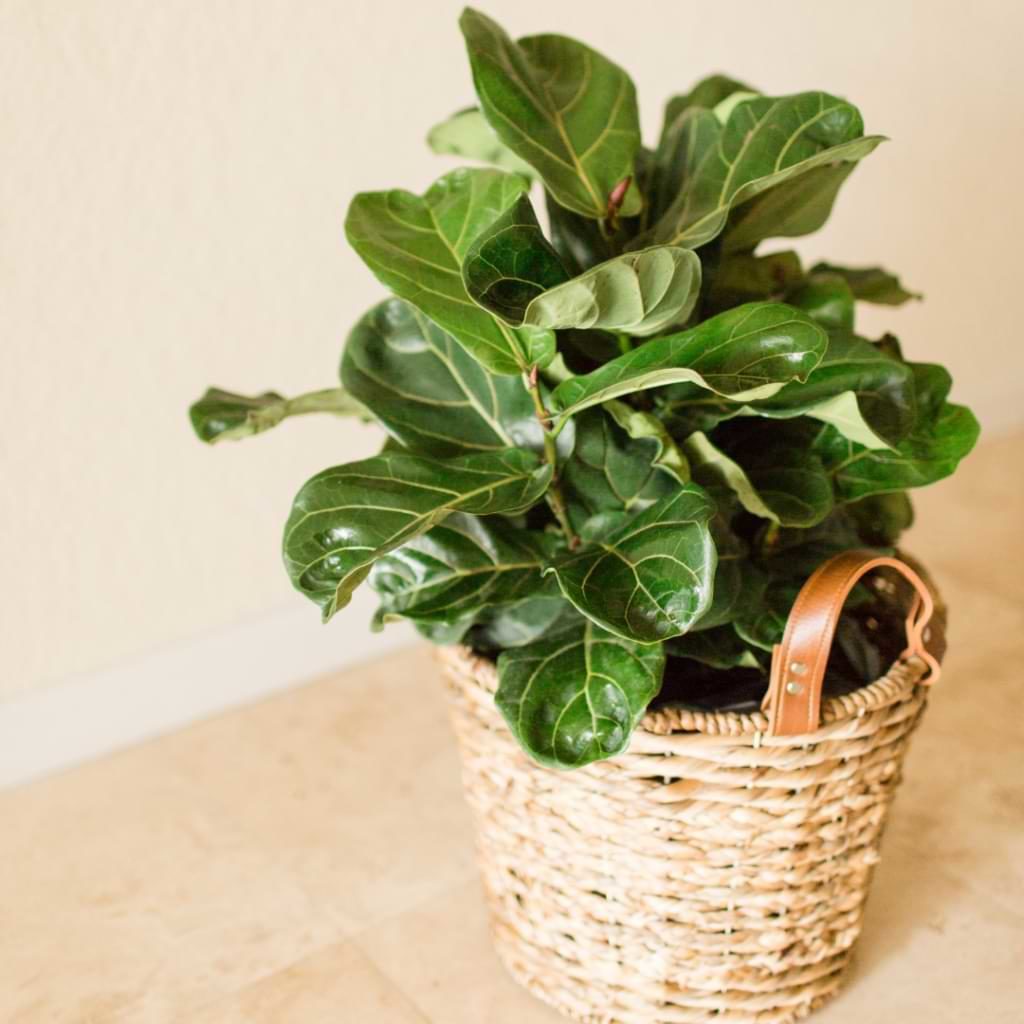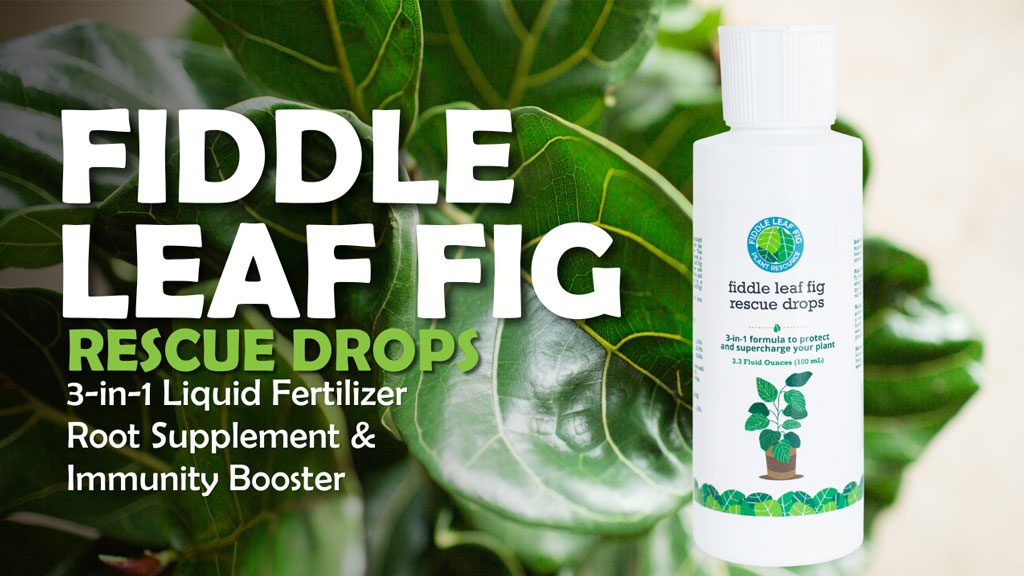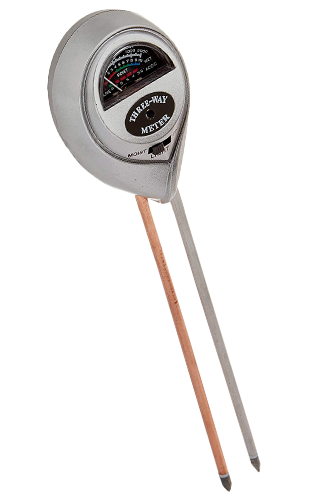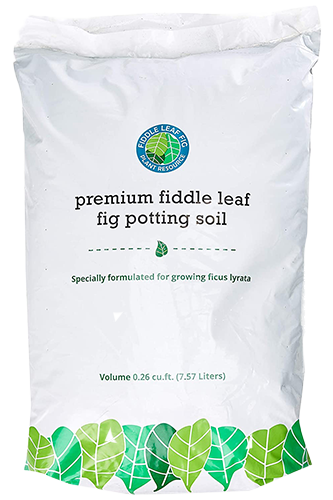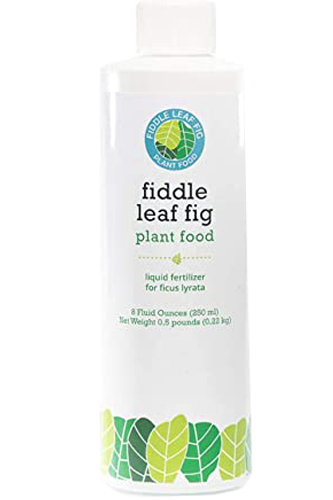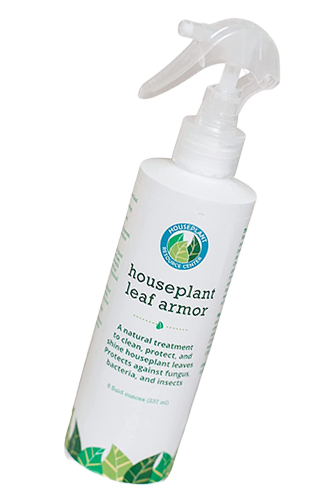When you think of a fiddle leaf fig, do you think of that distinctive, lollipop-shaped tree that’s all over social media? Or do you think of a full, lush fiddle leaf fig bush with lots of gorgeous leaves all the way down the trunk? A standard fiddle leaf fig tree can grow either way!
Which type do you prefer?
While the fiddle leaf tree shape is popular, a lot of fiddle fans actually prefer their fiddles more bush-shaped. We think both are beautiful, but we wanted to give the bushy fiddles some attention!
You can find lots of information about cultivating a tree-shaped fiddle leaf fig, but what if you’re going for the more bushy look? In this article, we’ll show you how to get that lush, thick foliage you’re after.
Fiddle Leaf Fig Bush Vs. Tree
You might wonder if there’s a difference between a fiddle leaf fig bush and a tree.
Answer: They’re the exact same plant, the only difference is the shape!
One shape isn’t necessarily “better” than the other. A tree shape isn’t healthier for your fiddle leaf fig than a bushier shape, and vice versa. It’s entirely a matter of personal preference and cultivation.
The good news is that a bush shape is easier to cultivate in a lot of ways because your fiddle will naturally grow this way. That lollipop shape so many fiddle fans covet actually takes a lot of careful shaping and pruning to get the tree to branch out where you want and to remove the leaves from where you don’t want.
There are some steps you can take to shape a bush, however, and to encourage your tree to grow more leaves and even branches when you want them!
How to Nurture a Fiddle Leaf Fig Tree Into a Bush
Nurturing a bushy fiddle leaf fig is fairly simple.
The best way to get a full, leafy fiddle is to provide enough light, water, and nutrients so that the tree can grow lots of leaves that are fairly close together.
Without sufficient light, your fiddle will get leggy and won’t have the energy to grow lots of leaves. Without enough water and nutrients, it will grow smaller and fewer leaves, and will also be shorter overall!
But what if you have a fiddle that’s already shaped into a tree? Can you reshape it into a bush?
Here the answer is…kind of. If you have a long, bare trunk, there are steps you can take to encourage it to grow branches lower down. However, it’s definitely easier to start with a small fiddle and let it grow into its natural bushy shape.
Take your plant propagation to the next level with our exclusive Notching Bundle, the essential tool for fostering healthier growth and lush foliage in your plants! https://amzn.to/463xe6W
Here are some tricks for shaping your fiddle leaf fig bush.
Complete Guide to Notching Your Fiddle Leaf Fig
Notching and Pruning a Bush
Fiddles will grow fairly bushy if you do nothing at all, but you might want to grow a few branches or prune a few damaged leaves. If your tree gets TOO bushy, it’s also a good idea to thin out any crowded areas to promote airflow between the leaves. This prevents insect infestations and the growth of fungal diseases like powdery mildew.
If you do choose to notch and/or prune, here’s what you need to know:
Notching
Notching is a technique to encourage your tree to branch in a certain place. To do this, first pick out the general area on the trunk where you’d like a branch, and find the nearest node. This will look like a slight thickening of the trunk. Using a sharp, clean knife or pair of shears tilted at a downward 45-degree angle, make a small cut about ¼ of the way through the trunk. Then make a cut just below that at an upward 45-degree angle to make a small notch in the trunk.
Tip: Make sure to wear gloves and have a towel handy to catch the sap.
If you’re lucky, you may see a new branch beginning to form within a few months!
Notching only has a 30-50% success rate, however, so don’t feel bad if it doesn’t work! You can just try again if you don’t see any progress after a while. You may also want to make up to 2-3 cuts on a smaller tree or 5-6 on a bigger one. This should increase your chances of getting a branch or two!
Here’s an in-depth, step-by-step guide on notching your fiddle leaf fig.
Pruning
Pruning is the process of removing leaves and branches from your tree. To do this, plan your cuts in advance so you can envision the shape of your tree before making changes you can’t reverse. Then use a sharp, clean pair of shears to remove up to 10% of the leaves and branches at a time. You can use this technique to shape your tree or to simply remove dead or diseased material to keep the rest of the tree healthy.
As with notching, it’s a good idea to wear gloves and use a towel to catch the sap and protect your floors and furniture.
Spring is a great time for both of these techniques because that’s when your tree is probably gearing up for a growth spurt. This means that you can take advantage of those growth hormones and raise your chances of getting a branch where you want it. It also helps your fiddle recover more quickly from being pruned or notched.
Here’s a helpful how-to video for pruning your fiddle leaf fig.
Caring for Your Fiddle Leaf Fig Bush
The best way to get a beautiful, bushy fiddle is to provide everything it needs to grow lots of those large, lyre-shaped leaves.
This means creating the right light conditions, watering properly, and giving your tree the nutrients it needs to grow.
Light
Fiddles need light to create the energy for growth (and all other physical processes). If your fiddle doesn’t get enough sunlight, it won’t grow as many leaves, and the leaves it DOES grow likely won’t get as big. Additionally, your tree may get “leggy” or grow a lot of space between the leaves if it doesn’t get enough sunlight. Not good, if you’re going for the bushy look!
Make sure to put your tree in a spot where it will get lots of bright, indirect sunlight for most of the day. An east-facing window is perfect, and a south- or west-facing window can also work if you put the tree far enough back that it will still get lots of light, but where the sun’s rays won’t fall directly on the leaves.
You can also condition your fiddle to tolerate (and even thrive in) full sun. This is a good idea for a lot of reasons! A tree that’s acclimated to full sun tends to recover more quickly from being moved and will often be hardier overall. Here’s how to acclimate your tree to full sun.
If you aren’t sure whether your lighting conditions are ideal for a fiddle, you can use a light meter to test them. If you don’t have enough natural light in your space, you can always supplement with a grow light. We love these full-spectrum bulbs that you can simply screw into ordinary light fixtures!
Water
Giving your tree the right amount of water is crucial for the health and growth of your plant!
We recommend monitoring the moisture level of your plant’s soil to know when it needs water rather than watering on a strict schedule. It’s important that you learn to take cues from your plant so you can avoid over- and underwatering, because both will inhibit your fiddle’s growth and leaf production.
Fiddles like consistently damp soil, but will quickly develop root rot if they sit in soggy soil for too long. Letting the soil dry out will also slow down your plant’s growth, which won’t get you closer to your goal of cultivating a full, bushy tree!
As a general rule, when the top 2-3 inches of your fiddle’s soil feel dry to the touch or, better yet, when a moisture meter reads 3-4, it’s time to water your tree. When you water, make sure to give the soil a good soaking and then let it drain completely. For a healthy tree that’s getting enough light and has good drainage, this should mean that you’re watering every 7-10 days.
A note on drainage: Make sure your pot has drainage holes and that your soil drains very well (our Premium Fiddle Leaf Fig Soil is great for this!). Often, watering issues are caused by poor drainage, not actually watering too little or too much.
Fertilizer
Another piece of the bushy-tree puzzle is nutrients. After all, those big leaves require a lot of vitamins and minerals to grow!
In nature, fiddles get all the nutrients they need from their soil. A potted fiddle only has access to the nutrients present in its potting mix and can easily use up all those nutrients in just a few months!
If your fiddle has been in its current pot and soil for at least a month or two, it might be time to start fertilizing. Fertilizers generally come in two types, liquid and slow-release, which you can buy in pellet or stick form. We prefer liquid fertilizers because it’s easier to control how much your plant is actually getting. Make sure to read the label carefully and follow the instructions so that you properly dilute the fertilizer. The last thing you want is chemical burns on your roots!
We recommend using Fiddle Leaf Fig Food with each watering during the spring and summer when your fiddle is most likely to be actively growing, and around once a month during the fall and winter when it may be experiencing a more dormant period.
This fertilizer is gentle enough to use with each watering during the growth season, and you won’t have to remember a fetilization schedule! It’s also specifically formulated for fiddles to promote the growth of strong stems, large leaves, and a hardy root system to support it all.
Can You Turn a Fiddle Leaf Fig Bush Into a Tree?
If you change your mind and decide you want to turn your bushy fiddle into a tree, no problem!
The way to do this is to start removing the lower leaves, and notching or pinching to encourage branching.
We explained notching and pruning earlier, and those techniques are supremely helpful for shaping your tree. But, again, make sure not to remove more than 10% of your tree’s leaves at a time to prevent sending it into shock.
Here’s our guide on pruning and shaping a fiddle leaf fig into a tree.
Let’s talk about pinching: this technique encourages your fiddle to branch out from the top. To do this, use a sharp, clean pair of shears to cut off the very top of your fiddle, just below the newest growth. With luck, your tree will branch from that point instead of growing straight up like it probably has been until it was pinched.
Again, use gloves and a towel to protect your hands, furniture, and flooring from the irritating sap. The best time to do this is in the spring when your tree might experience a growth spurt. This will increase your chances of getting new branches and will help your tree recover faster!
Final Thoughts on Fiddle Leaf Fig Bush
Ultimately, growing a beautiful fiddle leaf fig bush is simply about taking good care of your plant and doing minimal work to control its shape. Many fiddle leaf fig owners prefer the bushy look over the manicured tree shape, and find it a lot easier to grow too!
It comes down to a matter of personal preference and proper care.
This site is full of resources to help you grow the healthiest, most gorgeous fiddle leaf fig ever, whether you’re on Team Tree or Team Bush!
If you have questions or need support for your bushy fiddle leaf fig, come join our online community by clicking below!

